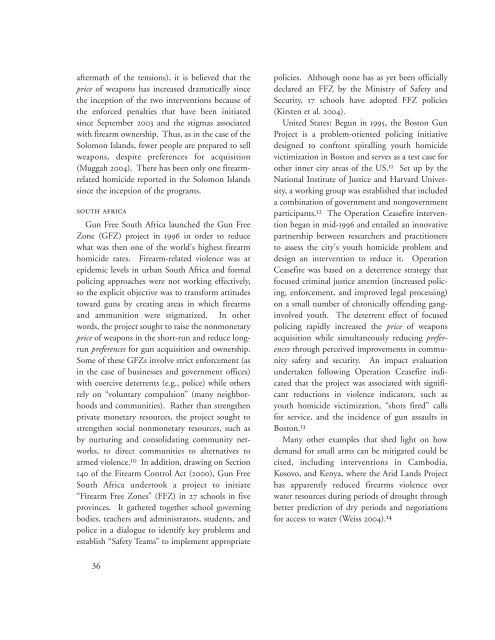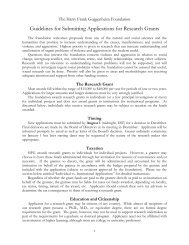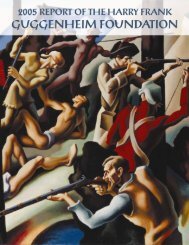aftermath of the tensions), it is believed that theprice of weapons has increased dramatically sincethe inception of the two interventions because ofthe enforced penalties that have been initiatedsince September 2003 <strong>and</strong> the stigmas associatedwith firearm ownership. Thus, as in the case of theSolomon Isl<strong>and</strong>s, fewer people are prepared to sellweapons, despite preferences for acquisition(Muggah 2004). There has been only one firearmrelatedhomicide reported in the Solomon Isl<strong>and</strong>ssince the inception of the programs.south africaGun Free South Africa launched the Gun FreeZone (GFZ) project in 1996 in order to reducewhat was then one of the world's highest firearmhomicide rates. Firearm-related violence was atepidemic levels in urban South Africa <strong>and</strong> formalpolicing approaches were not working effectively,so the explicit objective was to transform attitudestoward guns by creating areas in which firearms<strong>and</strong> ammunition were stigmatized. In otherwords, the project sought to raise the nonmonetaryprice of weapons in the short-run <strong>and</strong> reduce longrunpreferences for gun acquisition <strong>and</strong> ownership.Some of these GFZs involve strict enforcement (asin the case of businesses <strong>and</strong> government offices)with coercive deterrents (e.g., police) while othersrely on “voluntary compulsion” (many neighborhoods<strong>and</strong> communities). Rather than strengthenprivate monetary resources, the project sought tostrengthen social nonmonetary resources, such asby nurturing <strong>and</strong> consolidating community networks,to direct communities to alternatives toarmed violence. 10 In addition, drawing on Section140 of the Firearm Control Act (2000), Gun FreeSouth Africa undertook a project to initiate“Firearm Free Zones” (FFZ) in 27 schools in fiveprovinces. It gathered together school governingbodies, teachers <strong>and</strong> administrators, students, <strong>and</strong>police in a dialogue to identify key problems <strong>and</strong>establish “Safety Teams” to implement appropriatepolicies. Although none has as yet been officiallydeclared an FFZ by the Ministry of Safety <strong>and</strong>Security, 17 schools have adopted FFZ policies(Kirsten et al. 2004).United States: Begun in 1995, the Boston GunProject is a problem-oriented policing initiativedesigned to confront spiralling youth homicidevictimization in Boston <strong>and</strong> serves as a test case forother inner city areas of the US. 11 Set up by theNational Institute of Justice <strong>and</strong> Harvard University,a working group was established that includeda combination of government <strong>and</strong> nongovernmentparticipants. 12 The Operation Ceasefire interventionbegan in mid-1996 <strong>and</strong> entailed an innovativepartnership between researchers <strong>and</strong> practitionersto assess the city's youth homicide problem <strong>and</strong>design an intervention to reduce it. OperationCeasefire was based on a deterrence strategy thatfocused criminal justice attention (increased policing,enforcement, <strong>and</strong> improved legal processing)on a small number of chronically offending ganginvolvedyouth. The deterrent effect of focusedpolicing rapidly increased the price of weaponsacquisition while simultaneously reducing preferencesthrough perceived improvements in communitysafety <strong>and</strong> security. An impact evaluationundertaken following Operation Ceasefire indicatedthat the project was associated with significantreductions in violence indicators, such asyouth homicide victimization, “shots fired” callsfor service, <strong>and</strong> the incidence of gun assaults inBoston. 13Many other examples that shed light on howdem<strong>and</strong> for small arms can be mitigated could becited, including interventions in Cambodia,Kosovo, <strong>and</strong> Kenya, where the Arid L<strong>and</strong>s Projecthas apparently reduced firearms violence overwater resources during periods of drought throughbetter prediction of dry periods <strong>and</strong> negotiationsfor access to water (Weiss 2004). 1436
ConclusionsThe dem<strong>and</strong> model summarized in this articleserves at least two purposes. First, it demonstratesthat the small arms issue cannot be conceived ofsolely from a supply-side perspective; indeed, theexclusive focus on the supply side may lead to inappropriatepolicies. Second, the means <strong>and</strong> motivations(or preferences, prices, <strong>and</strong> resources)approach h<strong>and</strong>ily categorizes a set of issues of anotherwise vast scale <strong>and</strong> complexity <strong>and</strong> reducesthem to an analytically tractable framework fromwhich action-oriented research <strong>and</strong> policy strategyflows.The dem<strong>and</strong> framework has conceptual <strong>and</strong>practical applications. It demonstrates fallacies ofa one-size-fits-all approach to reducing the dem<strong>and</strong>for small arms. The theory predicts, for instance,that the provision of development assistance(resources) in a context where preferences for smallarms are high <strong>and</strong> prices low may have ambiguous,as opposed to positive, impacts on the availability<strong>and</strong> use of small arms. Generating a more sophisticatedunderst<strong>and</strong>ing of how preferences, resources,<strong>and</strong> prices influence the dem<strong>and</strong> for firearms couldusefully inform both disarmament <strong>and</strong> developmentinterventions.Notes1. The United Nations convened a Conference onthe Illicit Trade of <strong>Small</strong> <strong>Arms</strong> <strong>and</strong> <strong>Light</strong> <strong>Weapons</strong> in Allits Aspects in July 2001. The Conference resulted in aProgramme of Action which (politically) committedstates to, among other things, making illicit firearmmanufacture <strong>and</strong> possession a criminal offense; identifying<strong>and</strong> destroying surplus weapons; tracking officiallyheld weapons; notifying original supplier nations of “reexport”;undertaking disarmament, demobilization, <strong>and</strong>reintegration (DDR); supporting regional agreements<strong>and</strong> moratoria; marking <strong>and</strong> tracing of weapons; <strong>and</strong>improving information exchange <strong>and</strong> the enforcementof arms embargoes.2. See, for example, <strong>Small</strong> <strong>Arms</strong> Survey 2001 <strong>and</strong>2003, Oxford: Oxford University Press.3. See Buchanan <strong>and</strong> Atwood 2003, Jackman 2003,<strong>and</strong> WHO 2002.4. A number of studies reveal common patterns associatedwith the dem<strong>and</strong> for weapons as well as interventionsthat appear to reduce preferences for weapons.These include (1) initiatives aimed at strengthening selfworth, identity, <strong>and</strong> positive social roles for individuals,especially children <strong>and</strong> youth, <strong>and</strong> particularly boys; (2)programs focused on community economic <strong>and</strong> socialdevelopment, with broad participation in creating jobs,housing, recreation opportunities, schooling, <strong>and</strong> cleanwater; (3) approaches to improve the capacity to resolveconflict nonviolently, including conflict-managementtraining <strong>and</strong> direct intergroup peacemaking, sometimesusing traditional indigenous processes; (4) policies tostrengthen governance so that it is more accountable tothe society it serves, establishing community policing,reforming <strong>and</strong> retraining the police, <strong>and</strong> working for anhonest, independent judiciary; <strong>and</strong> (5) broad efforts toimprove public access to government, increase publicparticipation in government, <strong>and</strong> end the marginalizationof some groups.5. For a fully elaborated explication of this theory ofdem<strong>and</strong>, see Muggah <strong>and</strong> Brauer 2004 <strong>and</strong> Brauer <strong>and</strong>Muggah 2006 (forthcoming). See also Muggah 2004.6. A. Skedsmo, K. Danhier, <strong>and</strong> H. Gor Luak, “TheChanging Meaning of <strong>Small</strong> <strong>Arms</strong> in Nuer Society,”African Security Review 12: 65-66, 2003.7. See, for example, the <strong>Small</strong> <strong>Arms</strong> Survey 2005(forthcoming), “Post-What: Disarmament, Demobilization,<strong>and</strong> Reintegration <strong>and</strong> <strong>Weapons</strong> Reduction in theAftermath of War.” Oxford: Oxford University Press.8. See Muggah 2004.9. See, for example, the report by Nelson <strong>and</strong>Muggah (2004) at http://www.smallarmssurvey.org.10. The <strong>Small</strong> <strong>Arms</strong> Survey has commissioned anevaluation of the Gun Free Zone initiative to test theassumption that it has successfully reduced dem<strong>and</strong>.Results will be published <strong>and</strong> distributed in 2005.11. Overall youth homicide had increased 230 percent—from 22 victims in 1987 to 73 victims in 1990—while averaging some 44 per year between 1991 <strong>and</strong> 1995.12. Including the Boston Police Department; theMassachusetts departments of probation <strong>and</strong> parole; theoffice of the Suffolk County District Attorney; the officeof the United States Attorney; the Bureau of Alcohol,Tobacco, <strong>and</strong> Firearms; the Massachusetts Departmentof Youth Services (juvenile corrections); Boston SchoolPolice; <strong>and</strong> gang outreach <strong>and</strong> prevention “street workers”attached to the Boston Community Centers program.Regular partners later in the process included theTen Point Coalition of activist black clergy, the Drug37




